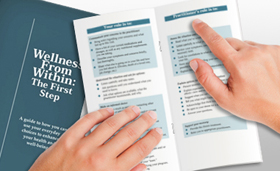Search Results
To Diet or Not to Diet?

Judy E. Buss
Landmark periods, such as the arrival of spring, or the beginning of a new year, inspire many of us to start doing something different to improve our lives. Trying a new diet for overall better health or for weight loss is a common choice. If your health practitioner recommended that you maintain a specific diet, do follow his/her instructions. However, if your own past attempts to adopt various diets didn’t pan out, it’s time to focus your laser beam on the likely reasons: Some diets made you constantly hungry; others, eliminated one or more food groups leading to nutrient deficiencies and illness; too challenging to maintain and required an unreasonable amount of time investment for meal preparations; you couldn’t dine away from home in restaurants or while visiting family. With other diets, you were inconsistent and cheated too often – wink wink…
The word “diet” has two meanings: A) the kinds of food that a person or animal eats B) a special course of food to which one restricts oneself for medical, religious, ethical, or other reasons. Keep in mind that in order to maintain good health, our bodies depend on a vast array of nutrients. In most cases, eliminating one or more food groups, consuming unhealthy foods, and/or overeating, greatly contributes to the development of chronic diseases, quality of life issues, and high medical expenses.
Experts who examined more than 40 diets, have come to the conclusion that for the majority of folks, a simple way to eliminate or improve health challenges is to adopt the eating habits adhered to by people living in countries surrounding the Mediterranean Sea. Rather than being a restrictive diet, as in vegetarian, Ketogenic, Atkins, and so forth, the Mediterranean diet is easy to maintain because it doesn’t place you in a “food prison.” Offering complete nutrition, it focuses on portion control and consumption of whole (minimally processed) fare in all food groups. It avoids junk and highly processed foods and beverages.
The Mediterranean people eat lots of fresh vegetables and fruits, nuts, seeds, beans, whole grains, seafood, some poultry, dairy, olive oil, and a limited amount of red meat. This eating pattern is part of a healthy lifestyle in general. Embark on a Mediterranean health-promoting journey!
MEDITERRANEAN-STYLE PASTA
2 servings
1-3/4 cups uncooked, whole grain corkscrew-shaped pasta
Olive oil divided:
1 tablespoon olive oil
2 tablespoons olive oil
1 yellow onion, chopped
3 cloves garlic, finely chopped
1/2 green bell pepper, seeded, cut into one-inch sticks
1/2 red bell pepper, seeded, cut into one-inch sticks
1/2 tablespoon dried oregano
Salt and pepper to taste
1/4 cup crumbled feta cheese
1. TO COOK THE PASTA: Fill a large saucepan 2/3 with water. Add 1 tablespoon oil. Cover and bring the water to a rolling boil. Gently mix in the pasta. Reduce the heat to low, and leaving the cover partially open, cook slowly 8 – 10 minutes, mixing once more. Drain.
2. Meanwhile, heat the oil in a large skillet over medium heat. Add the onion and garlic, cover, reduce the heat and cook about 12 minutes, until the onion is translucent, stirring once or twice. Add the bell peppers, oregano, salt, and pepper and cook (covered) 7 – 10 minutes, stirring twice, until the pepper is tender-crisp.
3. Remove the bell pepper mixture from the stove and add the feta. Stir the bell pepper mixture into the pasta.
4. Serve hot or cold.
FARM-FRESH CRUNCHY SALAD
2 servings
3 Romaine lettuce leaves, shredded
1 small tomato, finely chopped
½ medium cucumber
1/4 green bell pepper, finely chopped
1 stalk celery, thinly sliced
1/2 cup thinly sliced red cabbage
1/2 cup coarsely chopped walnuts
1 cup sesame “chips” or another crunchy element
DRESSING:
2 tablespoons wine vinegar
3 tablespoons extra virgin olive oil
1-1/2 tablespoons soy sauce
Black pepper to taste
1. In a medium bowl, mix all the dressing ingredients.
2. Add all the other ingredients except the chips or crunchies.
3. Refrigerate in an airtight container for 30 minutes.
4. Add the crunchy topping and serve immediately.
GREEK-STYLE LENTIL SALAD
2 servings
3/4 cup uncooked brown lentils
1 stalk celery, thinly sliced
2 green onions, thinly sliced, including their whites
1 medium tomato, finely chopped
1/4 cup crumbled feta cheese
DRESSING:
2 tablespoons lemon juice
3 tablespoons extra virgin olive oil
1/4 cup packed, coarsely chopped fresh mint leaves (about 4 sprigs)
1/4 cup packed, chopped fresh parsley leaves (about 4 sprigs)
Salt and pepper to taste
1. TO COOK THE LENTILS: Pick through the lentils and discard stones, and debris. Rinse the lentils in a fine mesh strainer under running water and drain. Place the lentils in a small saucepan; add cold water to 1-1/2 inch above them. Cover and bring to a boil over medium-high heat. Reduce the heat to medium-low, and cook 3 minutes.
2. Remove from the stove, but do not drain. Let stand in the hot water 30 – 35 minutes until just tender. Now drain, and let cool.
3. In a medium bowl, whisk together all the dressing ingredients. Add the lentils and all the other ingredients. Refrigerate in an airtight container for one hour before serving.
SERVING SUGGESTION:
Serve with toasted whole grain pita wedges.
“Mission Nutrition” Tips and Recipes from Judy E. Buss, Syndicated Eating-for-Health Columnist
Stay tuned for more Judy E. Buss’ “Mission Nutrition” words of wisdom and recipes.




















